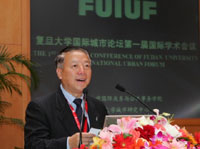|
 |
|
An official makes a speech at FUIUF.
|
Urbanization is speeding up throughout China, with half the 1.3 billion Chinese expected to live in cities in 2010.
Every year, about 13 million rural people flood into China's cities, equivalent to the current population of Beijing, Vice-Minister of Construction Qiu Baoxing told the Fudan University International Urban Forum1 over the weekend.
To accommodate this new urban population, the country needs a huge amount of resources, currently accounting2 for 40 per cent of the world's total annual cement consumption and 30 per cent of the annual steel consumption.
In addition, current construction projects account for around 30 per cent of the global total, said the vice-minister. He estimated that it would be another 30 years before the initial phase of China's urbanization is completed.
"Besides resource consumption, urbanization brings a lot of problems such as the widening wealth gap between urban and rural areas, environmental damage, the lack of social security for migrant workers and heavy pressure on transport networks," said Shan Wenhui, director of the Centre for Urban Studies at Fudan University.
Shi Nan, secretary-general of the Urban Planning Society of China, pointed3 out that it would be possible for the country to accommodate 50 per cent of its population in cities in 2010, since currently about 40 per cent of the population already lived in urban areas.
He said the government needed to seek solutions for swelling4 urban populations and shrinking resources.
Currently, three densely5 urbanized regions have formed along China's coast the Pearl River Delta6, the Yangtze River Delta and the Beijing-Tianjin-Hebei region.
New urban systems are also taking shape in the country's smaller cities and towns, due to economic development and the absorption of surplus rural labour.
Economic growth is the force driving this rapid urbanization. But other factors also attract farmers to the cities, Qiu explained, pointing to the development of transport networks and educational opportunities.
|
 收听单词发音
收听单词发音 
